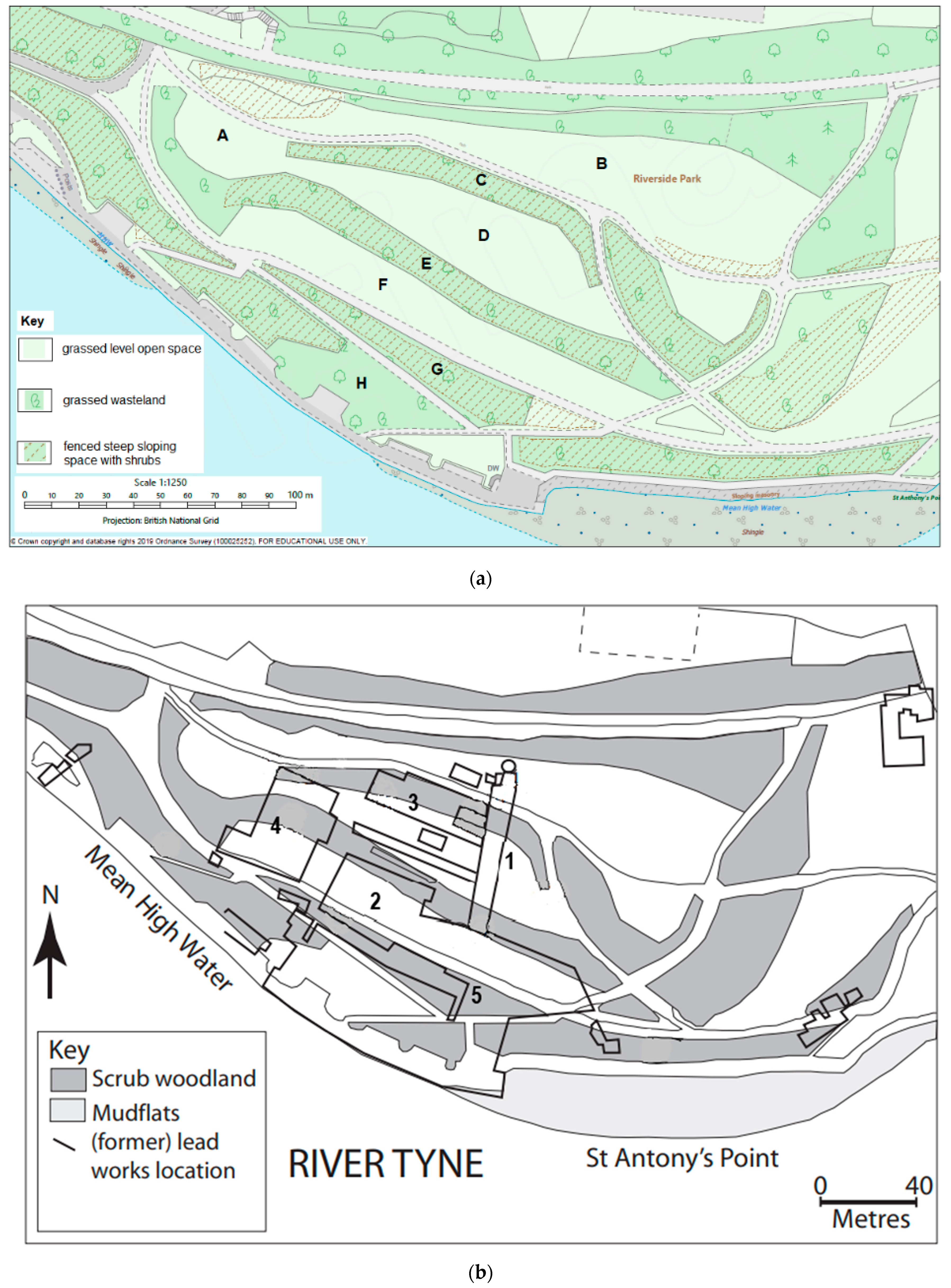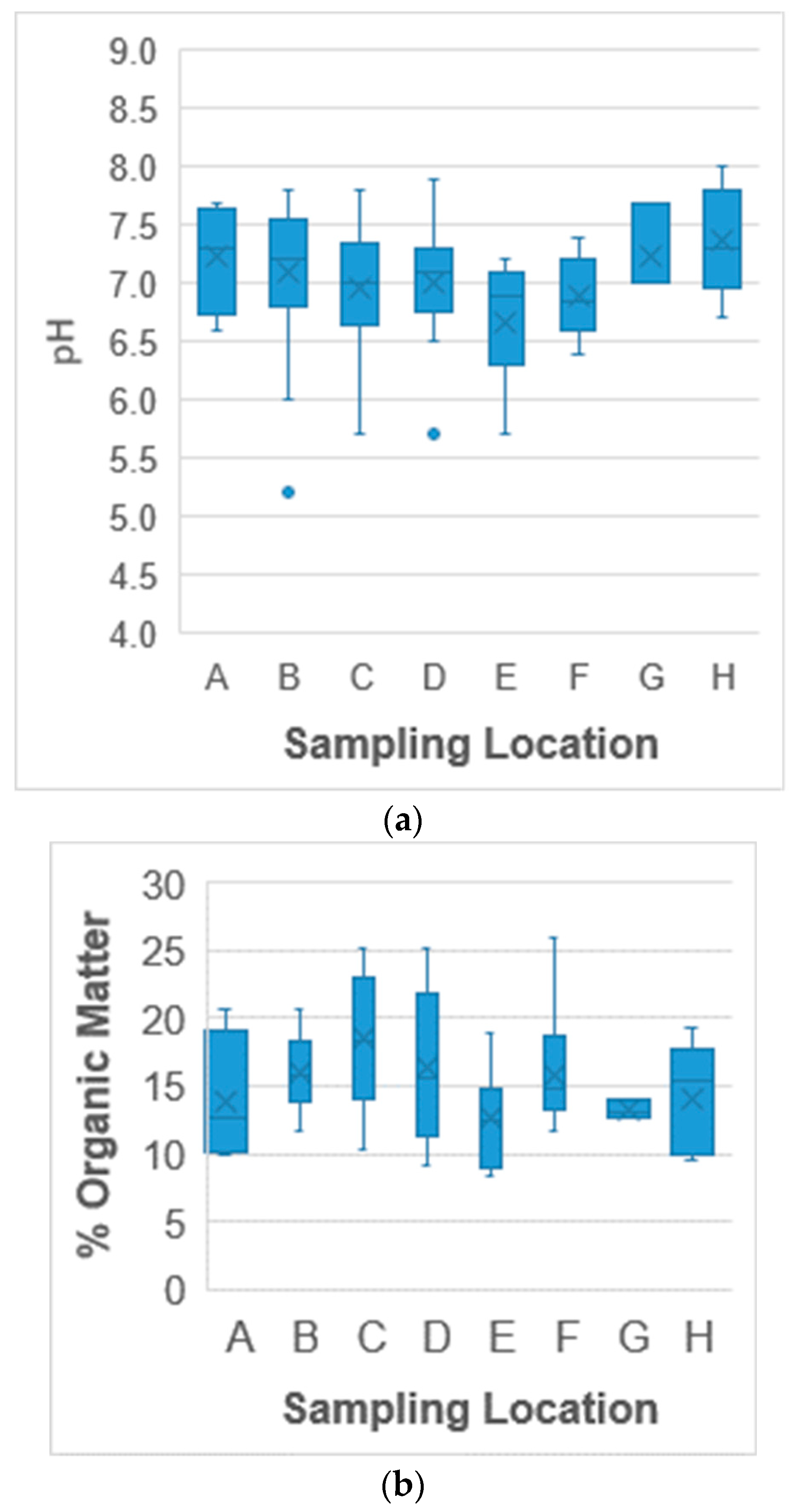Health Risk Assessment of Lead in Soils from an Historic Industrial Site in North-East England
Abstract
:1. Introduction
2. Materials and Methods
2.1. Certified Reference Materials (CRMs)
2.2. Soil Sample Collection and Pre-Treatment
2.3. Soil Sample pH and Organic Matter Content Determination
2.4. Soil Analysis by ED-XRF
2.5. Statistical Analysis
3. Results and Discussion
3.1. Characterization of the Topsoil Samples
3.2. Concentrations of Pb in Soils
3.3. Site Specific Risk Assessment
4. Conclusions
Supplementary Materials
Author Contributions
Funding
Institutional Review Board Statement
Informed Consent Statement
Data Availability Statement
Acknowledgments
Conflicts of Interest
References
- US EPA. Framework for Metal Risk Assessment. 2007. Available online: https://www.epa.gov/sites/default/files/2013-09/documents/metals-risk-assessment-final.pdf (accessed on 19 October 2021).
- US EPA. Regional Screening Levels (RSLs): Generic Tables. 2019. Available online: https://www.epa.gov/risk/regional-screening-levels-rsls-generic-tables (accessed on 19 October 2021).
- Chinese Ministry of Environmental Protection. Risk Screening Guideline Values for Soil Contamination of Development Land (3rd Draft Edition). 2016. Available online: https://www.mep.gov.cn (accessed on 19 October 2021).
- Cheng, Y.Y.; Tang, Y.T.; Nathanail, C.P. Determination of the potential implementation impact of 2016 ministry of environmental protection generic assessment criteria for potentially contaminated sites in China. Environ. Geochem. Health 2018, 40, 967–985. [Google Scholar] [CrossRef] [PubMed]
- DEFRA; EA. Soil Guideline Values for Lead Contamination, R&D Publication SGV10. 2002. Available online: https://www.gov.uk/government/publications/contaminated-soil-assessing-risks-on-human-health (accessed on 19 October 2021).
- CL:AIRE. Development of Category 4 Screening Levels for Assessment of Land Affected by Contamination. SP1010. 2013. Available online: https://www.claire.co.uk/projects-and-initiatives/category-4-screening-levels (accessed on 19 October 2021).
- Middleton, D.R.S.; Watts, M.J.; Beriro, D.J.; Hamilton, E.M.; Leonardi, G.S.; Fletcher, T.; Close, R.M.; Polya, D.A. Arsenic in residential soil and household dust in Cornwall, south west England: Potential human exposure and the influence of historical mining. Environ. Sci.: Processes Impacts 2017, 19, 517–527. [Google Scholar] [CrossRef] [PubMed] [Green Version]
- Entwistle, J.A.; Amaibi, P.M.; Dean, J.R.; Deary, M.E.; Medock, D.; Morton, J.; Rodushkin, I.; Bramwell, L. An apple a day? Assessing gardeners’ lead exposure in urban agriculture sites to improve the derivation of soil assessment criteria. Environ. Internat. 2019, 122, 130–141. [Google Scholar] [CrossRef] [PubMed]
- Lei, K.; Giubilato, E.; Critto, A.; Pan, H.Y.; Lin, C.Y. Contamination and human health risk of lead in soils around lead/zinc smelting areas in China. Environ. Sci. Pollut. Res. 2016, 13, 13128–13136. [Google Scholar] [CrossRef] [PubMed]
- Jiang, Z.C.; Guo, Z.H.; Peng, C.; Liu, X.; Zhou, Z.R.; Xiao, X.Y. Heavy metals in soils around non-ferrous smelteries in China: Status, health risks and control measures. Environ. Pollut. 2021, 282, 117038. [Google Scholar] [CrossRef] [PubMed]
- Harvey, P.J.; Taylor, M.P.; Kristensen, L.J.; Grant-Vest, S.; Rouillon, M.; Wu, L.; Handley, H.K. Evaluation and assessment of the efficacy of an abatement strategy in a former lead smelter community, Boolaroo, Australia. Environ. Geochem. Health 2016, 38, 941–954. [Google Scholar] [CrossRef] [PubMed]
- Souza, L.Z.S.; de Andrade Lima, L.R.P. Risk assessment for the presence of potentially toxic elements in the vicinity of a former lead smelter in Bahia, Brazil. Environ. Earth Sci. 2021, 80, 532:1–532:11. [Google Scholar] [CrossRef]
- Newcastle City Council: PHEP Environment and Culture Directorate. Former St. Anthony’s Lead Works Site Desktop Study; Newcastle City Council: Newcastle upon Tyne, UK, 2006; p. 36. [Google Scholar]
- Evening Chronicle. Walker Riverside Park Closed over Pollution. 28 July 2011. Available online: https://www.chroniclelive.co.uk/news/north-east-news/walker-riverside-park-closed-over-1402109 (accessed on 19 October 2021).
- Okorie, A.; Entwistle, J.; Dean, J.R. The optimization of microwave digestion procedures and application to an evaluation of potentially toxic element contamination on a former industrial site. Talanta 2010, 82, 1421–1425. [Google Scholar] [CrossRef] [PubMed]
- Okorie, A.; Entwistle, J.; Dean, J.R. The application of in vitro gastrointestinal extraction to assess oral bioaccessibility of potentially toxic elements from an urban recreational site. Appl. Geochem. 2011, 26, 789–796. [Google Scholar] [CrossRef]
- Rowell, D.L. Soil Science—Methods & Applications; Pearson Education: Essex, UK, 1994. [Google Scholar]
- Avery, B.W.; Bascomb, C.L. Soil Survey Laboratory Methods. Soil Survey of England and Wales Technical Monograph, No. 6; Rothamsted Experimental Station: Harpenden, UK, 1987. [Google Scholar]
- CL:AIRE/CIEH. Guidance on Comparing Soil Contamination Data with a Critical Concentration. 2008. Available online: https://www.cieh.org/media/1237/guidance-on-comparing-soil-contamination-data-with-a-critical-concentration.pdf (accessed on 19 October 2021).



| CRM | Certified Value | Measured Value |
|---|---|---|
| GBW 07401 | 98 ± 8 | 84.9 ± 0.6 |
| GBW 07402 | 20.2 ± 4 | 17.6 ± 0.3 |
| GBW 07406 | 314 ± 20 | 272.1 ± 1.2 |
| GBW 07407 | 14 ± 3 | 10.1 ± 0.3 |
| BCR 144R | 106 ± 4 | 80.0 ± 0.3 |
| BCR 146R | 609 ± 14 | 514.3 ± 1.0 |
| SRM 2710 | 5532 ± 80 | 5102 ± 4 |
| SRM 2711 | 1162 ± 31 | 1077 ± 2 |
| Parameter | CLEA Defaults for C4SL-POSpark | Adopted Parameters for the SSAC | Justification |
|---|---|---|---|
| Exposure pathways | Oral (direct soil and dust ingestion), Dermal (outdoor), Inhalation (outdoor dust; outdoor vapour) | Default exposure pathways adopted | Exposure outdoor only. |
| pH; soil organic matter (SOM); soil type | 7; 6%; sandy loam | Default parameters adopted. | Default parameter not changed as there is no influence on metal assessment criteria of these parameters in the CLEA model. |
| Receptor | Female child, age classes (0–6 yrs) | Default parameters adopted. | Default parameters not changed. |
| Outdoor exposure frequency (days/year) | Age class 0–1 yr: 85 Age classes 1–6 yrs: 170 | Age class 0–1 yr: 0 Age classes 1–6 yrs: 100 | During site survey only adults walking dogs and children playing in the open spaces. Also, adult/youngsters access the site for access to the river for estuary fishing on a weekly basis. For a child we therefore estimate, due to seasonal differences, exposure of 100 days. None of the site users crossing the site were observed to remain within the site for more than 30 min, which is approximately the time taken to walk from one end of the site to the other. In addition, allowance is included in the exposure scenario for additional more intensive use during summer evenings and periods of good weather. |
| Occupancy period (outdoor hr/day) | 2.0 | 3.0 | |
| Relative bioavailability via soil ingestion | 0.6 for Pb | Default parameter adopted | Default not changed |
| C4SL for POSpark (mg/kg) | Pb: 1300 | Pb SSAC: 2862 |
| Sampling Area | A | B | C | D | E | F | G | H | All |
|---|---|---|---|---|---|---|---|---|---|
| (Sample Size, n) | (n = 4) | (n = 18) | (n = 9) | (n = 13) | (n = 7) | (n = 16) | (n = 3) | (n = 9) | (n = 79) |
| Sample mean (mg/kg) | 564 | 12,350 | 11,745 | 953 | 727 | 314 | 742 | 1417 | 4655 |
| Standard deviation | 545 | 48,371 | 23,072 | 1475 | 884 | 227 | 928 | 3063 | 24,405 |
| UCL on the true mean (mg/kg) | 1205 | 62,046 | 45,268 | 2737 | 2184 | 561 | 3078 | 5858 | 16,623 |
| Evidence level | 100% | 0% | 0% | 96% | 98% | 100% | 94% | 67% | 0% |
| Results | UCL < SSAC | UCL ≥ SSAC | UCL ≥ SSAC | UCL < SSAC | UCL < SSAC | UCL < SSAC | UCL ≈≥ SSAC | UCL ≈≥ SSAC | UCL ≥ SSAC |
Publisher’s Note: MDPI stays neutral with regard to jurisdictional claims in published maps and institutional affiliations. |
© 2022 by the authors. Licensee MDPI, Basel, Switzerland. This article is an open access article distributed under the terms and conditions of the Creative Commons Attribution (CC BY) license (https://creativecommons.org/licenses/by/4.0/).
Share and Cite
Ma, R.; Dean, J.R. Health Risk Assessment of Lead in Soils from an Historic Industrial Site in North-East England. Separations 2022, 9, 12. https://doi.org/10.3390/separations9010012
Ma R, Dean JR. Health Risk Assessment of Lead in Soils from an Historic Industrial Site in North-East England. Separations. 2022; 9(1):12. https://doi.org/10.3390/separations9010012
Chicago/Turabian StyleMa, Renli, and John R. Dean. 2022. "Health Risk Assessment of Lead in Soils from an Historic Industrial Site in North-East England" Separations 9, no. 1: 12. https://doi.org/10.3390/separations9010012






